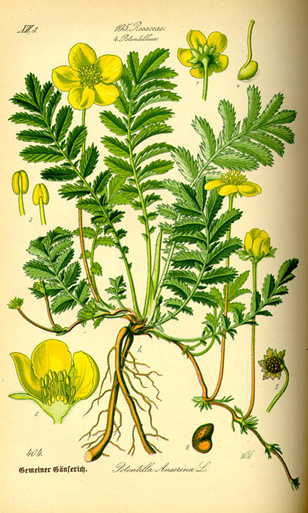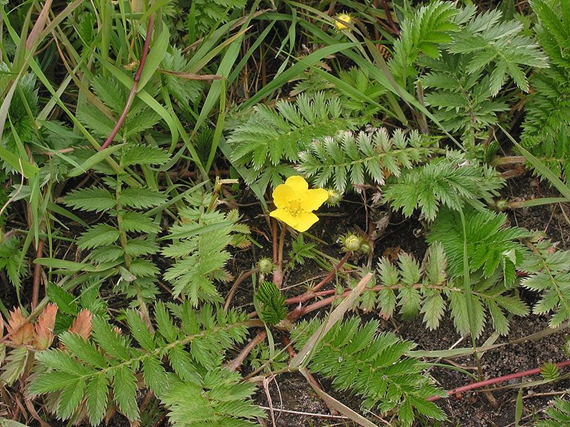And… BEFORE the potato came to Europe…
- hbeck217
- Apr 23, 2024
- 6 min read
Otto Wilhelm Thomé > Flora von Deutschland Österreich und der Schweiz (1885): Gemeiner Gänserich Potentilla anserina L. https://web.archive.org/web/20090607223156/http://caliban.mpiz-koeln.mpg.de/~stueber/thome/band3/tafel_088.html
In his book The Fascinating World of the Nightshades, Charles Heiser devotes a whole chapter to “How to Spend a Quiet Evening with a Potato”, quoting Edgar Anderson’s essay: “Get a potato, a nice big one, out of the bin, wash it off carefully, and sit down in a comfortable chair with a good light coming over your shoulder… Don’t be too tense and earnest. If you can get a friend with a kindred interest to join you, so much the better. [That sentence is followed by a full-page photograph of a potato eye and the question:]
… have you ever really looked a potato in the eye?”
Wikipedia Commons, Author: ZooFari released in public domain https://en.wikipedia.org/wiki/Potato#/media/File:Russet_potato_cultivar_with_sprouts.jpg
The following passages are so delightful (and relaxing), that I will let you discover it all for yourself, but this article on “before” is intended to talk about what people dug up, washed off, even looked at intensely, before the Columbian Exchange and the arrival of the potato on the scene in Europe, then elsewhere around the world. Heiser notes a potato is what botanists call a tuber, the swollen coalesced buds at the end of the underground stem, absolutely not a root, but part of the stem with joints… and it leads us to one of the world’s remarkable “case studies”.
In his classic account of the potato’s spread around the world, Redcliffe Salaman reflected on the rapidity or reluctance with which the potato was accepted. When the potato was willingly adopted, he posited that people already had a strong relation with root plants and practiced appropriate soil preparation techniques. Salaman particularly noted that Highland Scotland and the Hebrides were among the last areas to adopt widespread cultivation of the potato, tentatively attributing this to a general conservatism in food tastes, as in political organization.
What plant or plants were utilized there, that might have laid the ground, so to speak, for the potato? The late 19th-century Scottish folklorist, Alexander Carmichael, proposes a “root” that might fill the bill and which he directly linked to the potato, the silverweed (brisgein in Scottish Gaelic, probably Potentilla anserina L.):
‘The root was much used throughout the Highlands and Islands before the potato was introduced. It was cultivated, and so grew to a considerable size. As certain places are noted for the cultivation of the potato, so certain places are remembered for the cultivation of silverweed. One of these was Lag nan Tanchasg in Paible, North Uist, where a man could sustain himself on a square of ground of his own length. In dividing ‘mòrfhearann,’ common ground, the people lotted their land for ‘brisgein’ much as they lotted their fishing-banks at sea and their fish on shore. The poorer people exchanged ‘brisgein’ with the richer for corn and meal, quantity for quantity and quality for quality. The ‘brisgein’ was sometimes boiled in pots, sometimes roasted on stoves, and sometimes dried and ground into meal for bread and porridge. It was considered palatable and nutritious’.
Carmichael was seconded in mentioning the silverweed as widely eaten, by an earlier scholar and travel writer, Martin Martin (ca. 1660-1718), in a period that was a full century before adoption of the potato in the region. Martin’s notes were corroborated and expanded to yet broader coverage of the Highlands and Islands by Isabel Grant, founder of the Highland Folk Life Museum in the 20th century. Might our present concentration on the potato as a massively dominant underground dweller hint that the role of “root-plants” in general might have been given short shrift? The far more recent “tuber hypothesis” put forward by Richard Wrangham went in the opposite direction, proposing that hominid use of fire and the innovation of cooking tubers might have provided a quantum leap in nutrition, as well as influencing morphological and cognitive development….. so we might look more closely at this particular plant, the silverweed, to explore how it was perceived over time and find….
… that it was the object of a praise poem in Carmichael’s 19th-century Scottish testimony, where it is cited as “honey under ground, silverweed of spring”, along with other seasonal foods such as whisked whey in summer, carrot in autumn, crunchy nuts in winter. This homage from a century and a half ago is echoed for a broader category of underground vegetal denizens in a much older poem from Ireland, the 8th or 9th-century “Quatrains on the Seasons” dedicated to each of the four older quarter-days in the calendar system. The May Day verse speaks of “the glorious dues of May-day: ale, worts, sweet whey, and fresh curds to the fire.”
This puts the “root” question into an entirely different perspective, just as many of us recognize the potato as emblematic of a historical trauma that forced masses of people to escape famine. Indeed the verse celebrates what was once an existential issue. The “merry month of May” was quite often a killer – the time when grain stocks had run out and the life-saving dairy products were not yet in full swing, when “spring hunger” carried off the vulnerable, infants, their young mothers and the elderly. This is a compelling reason to listen carefully to information from a variety of elder sources, such as annals, laws, literature, even lyrics.
In early medieval times, the principal opponents of the Irish were the Irish and of the Scots, the Scots, with the occasional Viking incursion. When inter-group relations soured, it was common to visit your neighbors to rustle their cattle and burn their cereal crops. This was also standard practice in the later English colonization. The mention in the Quatrains of “worts” recalls that plants may also “speak” of the earth they grow in. The Old Irish term here is mecon, also translated as “parsnip” or “carrot”, and scholars chose a safe way out with the generic English term “tap-root”. Mecon was cited in early law texts as emblematic of high-quality land, suitable for growing cereal crops, called “three-wort land” (tír trí meccon) with the richest soil.
Wikipedia Creative Commons, Author: Rasback https://commons.wikimedia.org/wiki/File:Zilverschoon_plant_Potentilla_anserina.jpg
Turning back to the specific plant cited by Martin and then Carmichael, we find the silverweed described in remarkably similar ways on the other side of the planet, among the rich cultures of the Northwest Pacific Coast peoples of Canada and the United States. They prized the silverweed for its tastiness and variety, desirable texture and excellent keeping properties, all of which depended on the soil, the age of the stands, gathering times, and of course on the cook’s own merits, although it could also be munched on raw, if the gatherer felt a bit puckish. Groups that owned fine patches of silverweed (Potentilla anserina ssp. pacifica) saw it as forming a common ‘assemblage’ with springbank clover (Trifolium wormskioldii). The two plants were harvested at the same time and shared within the lineage, but also used in lavish hosting for the Festival of First Fruits and First Shoots at beginning and end of summer, just as the silverweed was associated in Ireland with the opening of the summer season on May Day, when there were large inter-tribal gatherings.
Roots harvested in March after the snow melted, but before top growth had started, the ideal time for full flavor and sweetening. Argentina anserina of the interior [Canadian West coast, photo and caption by Steve Dupey, experimental grower, Jan2012, abridged]
It suffices to examine a photograph of the silverweed “tubers” to imagine processing it was far more time-consuming and demanding of skills than roasting a few potatoes. This brings us back round to Salaman’s ruminations on adoption or reluctance towards the potato, but in a still broader context. He notes that the potato arrived during a period of reorganization of production in both Scotland and Ireland that included massive field turnip plantations to fuel the cattle trade with England and the continent. This major shift from domestic milk production to the international meat trade pushed most of the rural poor onto poorer soils, where only the potato grew well, creating a dangerous dependence. Repeated failures of the potato crop in the late eighteenth and early nineteenth centuries foreshadowed the “great” famine to come.
Written by
Cozette Griffin-Kremer, Associate Researcher, Centre de Recherche Breton et Celtique, Brest FR
Notes
Charles B. Heiser, jr. The Fascinating World of the Nightshades, Dover Publications, 1987, pp. 39-42.
For a far more developed article on the silverweed and the stakes involved in these transition issues, with full bibliography: Cozette Griffin-Kremer. “Silverweed: A food plant on the road from wild to cultivated?” in A. Chevalier, E. Marinova, L. Peña-Chocarro (eds). Plants and People: Choices and Diversity through Time, EARTH Series, Vol. 1, Oxbow, 2014, 242-249. https://www.academia.edu/35064305/Plants_and_People_Choices_and_Diversity_through_Time











Comments